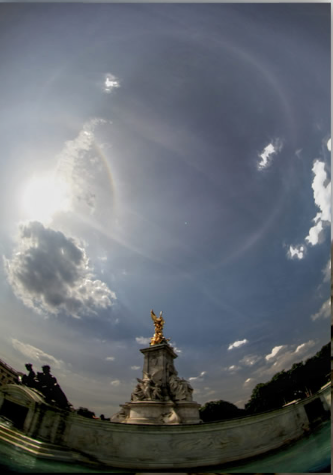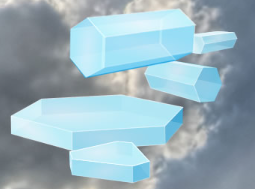Royal halos, Victoria Memorial, London - OPOD
Royal Halos: A Spectacular Atmospheric Phenomenon at the Victoria Memorial in London
Have you ever witnessed a breathtaking display of halos at the Queen Victoria Memorial in front of Buckingham Palace, London? These celestial marvels, captured by the talented photographer Simon Lericque, showcase the ethereal beauty of atmospheric optics. Let's delve deeper into the intricacies of these royal halos and explore the fascinating science behind their formation.
Unveiling the Spectacle
As you gaze upon the Queen Victoria Memorial, you'll notice the sun partially obscured by the bronze effigy of winged victory. Surrounding it, a weak 22° halo and the upper part of a circumscribed halo grace the sky. But that's not all – a white parhelic circle gracefully passes through the sun, encircling the sky at its altitude. Additionally, faint traces of white 120° parhelia add an enchanting touch to this celestial spectacle.
The Mysterious Parhelic Circle
One of the most captivating elements of this phenomenon is the parhelic circle. It is formed by plate crystals and columns in singly oriented and Parry orientations. The parts near the sun primarily arise from a single external reflection from a near-vertical crystal facet. However, as the distance from the sun increases, more intricate ray paths come into play, resulting in the formation of this mesmerizing parhelic circle.
Exploring the Science
To understand the formation of these halos, we need to delve into the science of atmospheric optics. Halos occur when light interacts with ice crystals suspended in the atmosphere. The crystals act as tiny prisms, bending and refracting light in various ways. As sunlight passes through these ice crystals, it undergoes refraction and reflection, leading to the creation of stunning optical phenomena.
The Role of Plate Crystals and Columns
Plate crystals and columns play a crucial role in the formation of halos. Plate crystals are flat, hexagonal ice crystals that resemble tiny plates. They often produce the 22° halo observed around the sun. On the other hand, columns are elongated ice crystals with six-sided prismatic shapes. These crystals can generate the circumscribed halo and contribute to the formation of the parhelic circle.
The Intricacies of Halo Formation
The creation of halos involves a complex interplay of light rays and ice crystals. When sunlight enters an ice crystal, it undergoes refraction, bending at different angles. As the light exits the crystal, it may undergo further refraction or reflection, resulting in the formation of halos at specific angles from the sun.
A Symphony of Light
The halos observed at the Queen Victoria Memorial exemplify the astonishing beauty of atmospheric optics. As light interacts with ice crystals in the atmosphere, it dances and refracts, painting the sky with a symphony of colors and shapes. These celestial displays serve as a reminder of the wondrous intricacies of our natural world.
Capturing the Beauty
Thanks to the skillful photography of Simon Lericque, we have the privilege of witnessing these awe-inspiring royal halos at the Victoria Memorial. Lericque's use of an 8mm fish-eye lens allows us to appreciate the grandeur of this atmospheric phenomenon in all its glory. Through his lens, we can truly marvel at the intricate details and mesmerizing patterns created by light and ice crystals.
A Moment of Majesty
The royal halos at the Queen Victoria Memorial stand as a testament to the captivating wonders that unfold in our atmosphere. This celestial spectacle is a reminder of the hidden beauty that surrounds us and invites us to pause, reflect, and appreciate the marvels of nature. So, next time you find yourself near Buckingham Palace, keep an eye out for these majestic halos and let yourself be enchanted by the celestial dance above.

Royal Halos
Halos over the Queen Victoria Memorial in front of Buckingham Palace, London. Imaged by Simon Lericque with an 8mm fish-eye lens.
The sun is shielded by the bronze effigy of winged victory. Surrounding it is a weak 22° halo and the upper part of a circumscribed halo. The white parhelic circle passes through the sun and encircles the sky at its altitude. There are traces of white 120° parhelia.
Her Majesty is not amused.
Images ©Simon Lericque, shown with permission


The parhelic circle is generated by plate crystals and also by columns in singly oriented and Parry orientations.
Parts near the sun come mostly from a single external reflection from a near vertical crystal facet. With increasing sun distance, more complicated ray paths become important.
Note: this article has been automatically converted from the old site and may not appear as intended. You can find the original article here.
Reference Atmospheric Optics
If you use any of the definitions, information, or data presented on Atmospheric Optics, please copy the link or reference below to properly credit us as the reference source. Thank you!
-
<a href="https://atoptics.co.uk/blog/royal-halos-victoria-memorial-london-opod/">Royal halos, Victoria Memorial, London - OPOD</a>
-
"Royal halos, Victoria Memorial, London - OPOD". Atmospheric Optics. Accessed on November 26, 2024. https://atoptics.co.uk/blog/royal-halos-victoria-memorial-london-opod/.
-
"Royal halos, Victoria Memorial, London - OPOD". Atmospheric Optics, https://atoptics.co.uk/blog/royal-halos-victoria-memorial-london-opod/. Accessed 26 November, 2024
-
Royal halos, Victoria Memorial, London - OPOD. Atmospheric Optics. Retrieved from https://atoptics.co.uk/blog/royal-halos-victoria-memorial-london-opod/.